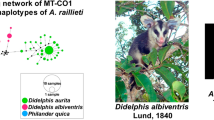Abstract
The genetic diversity of two samples of Cestoda (Bothriocephalus funiculus, Renaud and Gabrion, 1984) parasitizing two sympatric teleostean species was assessed using random amplified polymorphic DNA (RAPD). A total of 72Bothriocephalus were analyzed individually, and electrophoretic analysis of the amplification products of 65 primers among the 68 tested revealed monomorphic patterns, reflecting the close genetic relatedness within and between the parasites of the two samples. However, 3 primers showed polymorphic patterns at 6 RAPD sites. Analysis of the distribution of these genomic fragments, assuming random mating, showed strong linkage disequilibria (only 8 genetic combinations were observed among the 32 expected). Two genetic entities displaying a high degree of host specificity were evidence within our two samples ofB. funiculus. This powerful molecular technique can be used as a diagnostic tool in studies concerning the biodiversity of related genetic entities and could have broad applications in parasitology.
Similar content being viewed by others
References
Arnold ML, Buckner CM, Robinson JJ (1991) Pollen-mediated introgression and hybrid speciation in Louisiana irises. Proc Natl Acad Sci USA 88:1398–1402
Barral V, This P, Imbert-Establet D, Combes C, Delseny M (1993) Genetic variability and evolution of theSchistosoma genome analysed by using random amplified polymorphic DNA markers. Mol Biochem Parasitol 59:211–222
Benzecri JP (1973) L'analyse des données. Dunod, Paris
Brikun I, Kestutis S, Berg DE (1994) DNA sequence divergence among derivatives ofEscherichia coli K-12 detected by arbitrary primer PCR (random amplified polymorphic DNA) fingerprinting. J Bacteriol 176:1673–1682
Carlson JE, Tulsieram LK, Glaubitz JC, Luk VWK, Kauffeldt C, Rutledge R (1991) Segregation of random amplified DNA markers in F1 progeny of conifers. Theor Appl Genet 88:194–200
Caswell-Chen EP, Williamson VM, Wu FF (1992) Random amplified polymorphic DNA analysis ofHeterodera cruciferae andH. schachtii populations. J Nematol 2:343–351
Chapco W, Ashton NW, Martel RKB, Antonishyn N (1992) A feasibility study of the use of random amplified polymorphic DNA in the population genetics and systematics of grasshoppers. Genome 35:569–574
Curran J, Baillie DL, Webster JM (1985) Use of restriction fragment length differences to identify nematode species. Parasitology 90:137–144
Demeke T, Adams RP, Chibbar R (1992) Potential taxonomic use of random amplified polymorphic DNA. Theor Appl Genet 84:990–994
Dias Neto E, Pereira de Souza C, Rollinson D, Katz N, Pena SDJ, Simpson AJG (1993) The random amplification of polymorphic DNA allows the identification of strains and species of schistosome. Mol Biochem Parasitol 57:83–88
Fekete A, Bantle JA, Halling SM, Stich W (1992) Amplification fragment length polymorphism inBrucella strains by use of polymerase chain reaction with arbitrary primers. J Bacteriol 174:7778–7783
Gasser RB Morahan G, Mitchell GF (1991) Sexing larval stages ofSchistosoma mansoni by polymerase chain reaction. Mol Biochem Parasitol 47:255–258
Hadrys H, Balick M, Schierwater B (1992) Applications of random amplified polymorphic DNA (RAPD) in molecular ecology. Mol Ecol 1:55–63
He S, Ohm H, MacKenzie S (1992) Detection of DNA sequence polymorphisms among wheat varieties. Theor Appl Genet 84:573–578
Hu J, Quiros CF (1991) Identification of broccoli and cauliflower cultivars with RAPD markers. Plant Cell 10:505–511
Hunt GJ, Page REJ (1992) Patterns of inheritance with RAPD molecular markers reveal novel types of polymorphism in the honey bee. Theor Appl Genet 85:15–20
Lebart L, Morineau A, Warwick KA (1984) Multivariate descriptive statistical analysis. J Woley & Sons, New York
Lehmann PF, Lin D, Lasker BA (1992) Genotypic identification and characterization of species and strains within the genusCandida by using random amplified polymorphic DNA. J Clin Microbiol 30:3249–3254
Martin GB, Williams JGK, Tanksley SD (1991) Rapid identification of markers linked to aPseudomonas resistance gene in tomato by using random primers and near-isogenic lines. Proc Natl Acad Sci USA 88:2336–2340
Ortega JE, Valero A (1989) Differenciacion genetica entre dos poblaciones del complejoBothriocephalus scorpii (Pseudophyllidea: Bothriocephalidae). Rev Iber Parasitol 49:139–145
Piessens WF, McReynolds LA, Williams SA (1987) Highly repeated DNA sequences as species specific probes fromBrugia. Parasitol Today 3:378–379
Renaud F, Gabrion C (1984) Polymorphisme enzymatique de populations du groupeBothriocephalus scorpii (Mueller, 1776). Etude des parasites de divers Téléostéens des côtes du Finistère. Bull Soc Fr Parasitol 2:95–98
Renaud F, Gabrion G, Pasteur N (1983) Le complexeBothriocephalus scorpii (Mueller, 1776): différenciation par électrophorèse enzymatique des espèces parasites du turbot (Psetta maxima) et de la barbue (Scophthalmus rhombus). C R Acad Sci [III] 296:127–129
Renaud F, Gabrion P, Pasteur N (1986) Geographical divergence inBothriocephalus (Cestoda) of fishes demonstrated by enzyme electophoresis. Int J Parasitol 16:553–558
Rishi AK, McManus DP (1987) Genomic cloning of humanEchinococcus granulosus DNA: isolation of recombinant plasmids and their use as genetic markers in strain characterization. Parasitology 94:369–383
Robert F, Renaud F, Mathieu E, Gabrion C (1988) Importance of the paratenic host in the biology ofBothriocephalus gregarius (Cestoda, Pseudophyllidea), a parasite of the turbot (Psetta maxima). Int J Parasitol 18:611–621
Steindel M, Dias Neto E, De Menezes CLP, Romanha AJ, Simpson AJG (1993) Random amplified polymorphic DNA analysis ofTrypanosoma cruzi strains. Mol Biochem Parasitol 6:71–80
Unnasch TR (1987) DNA probes to identifyOnchocerca volvulus. Parasitol Today 3:377–378
Verneau O, Renaud F, Catzeflis F (1991) DNA reassociation kinetics and genome complexity of a fish (Psetta maxima: Teleostei) and its gut parasite (Bothriocephalus gregarius: Cestoda). Comp Biochem Physiol 99:883–886
Vierling R, Nguyen HT (1992) Use of RAPD markers to determine the genetic diversity of diploid wheat genotypes. Theor Appl Genet 84:835–838
Welsh J, McClelland M (1990) Fingerprinting genomes using PCR with arbitrary primers. Nucleic Acids Res 18:7213–7218
Welsh J, Petersen C, McClelland M (1991) Polymorphisms generated by arbitrary primed PCR in the mouse: application to strain identification and genetic mapping. Nucleic Acids Res 20:303–306
Williams JGK, Kubelik AR, Livak KJ, Rafalski JA, Tingey SV (1990) DNA polymorphisms amplified by arbitrary primers are useful as genetic markers. Nucleic Acids Res 18:6531–6535
Author information
Authors and Affiliations
Rights and permissions
About this article
Cite this article
Verneau, O., Thomas, F., de Meeüs, A. et al. Evidence of two genetic entities inBothriocephalus funiculus (Cestoda) detected by arbitrary-primer polymerase chain reaction random amplified polymorphic DNA fingerprinting. Parasitol Res 81, 591–594 (1995). https://doi.org/10.1007/BF00932026
Received:
Accepted:
Issue Date:
DOI: https://doi.org/10.1007/BF00932026




